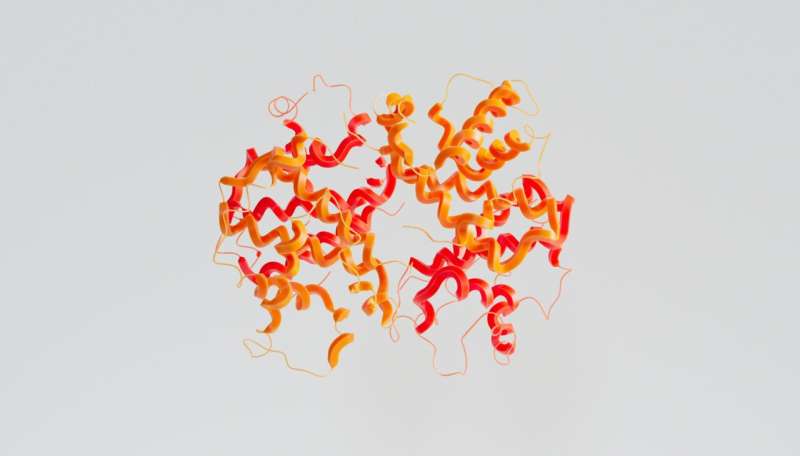 Credit: Unsplash/CC0 Public Domain
Credit: Unsplash/CC0 Public Domain
It’s not pleasant to shiver from the cold, but for some, it has the appeal of making the body burn more energy as heat than when staying in a warmer environment. According to several studies, exposure to cold is a reliable way to boost energy expenditure in mice and humans. This process of burning energy through heat loss is called thermogenesis.
While scientists and pharmaceutical companies are exploring ways to trick the body into thinking it’s cold—so that it activates thermogenesis and burns energy without the need for ice baths or winter walks in a T-shirt—obesity researchers Phi…
 Credit: Unsplash/CC0 Public Domain
Credit: Unsplash/CC0 Public Domain
It’s not pleasant to shiver from the cold, but for some, it has the appeal of making the body burn more energy as heat than when staying in a warmer environment. According to several studies, exposure to cold is a reliable way to boost energy expenditure in mice and humans. This process of burning energy through heat loss is called thermogenesis.
While scientists and pharmaceutical companies are exploring ways to trick the body into thinking it’s cold—so that it activates thermogenesis and burns energy without the need for ice baths or winter walks in a T-shirt—obesity researchers Philip Ruppert and Jan-Wilhelm Kornfeld from the Department of Biochemistry and Molecular Biology (BMB), University of Southern Denmark, set out to investigate another route: a form of thermogenesis triggered by eating specialized diets rather than temperature.
The team’s paper is published in the journal eLife.
Amino acids methionine and cysteine
After conducting a series of mouse studies, the researchers concluded that diet-induced thermogenesis led to nearly the same amount of weight loss as 24/7 exposure to five degrees Celsius.
The study was carried out together with BMB colleagues Aylin Güller, Marcus Rosendahl, and Natasa Stanic.
More specifically, the researchers adjusted the amount of the amino acids methionine and cysteine in the mice’s diet over a seven-day period. Mice that received a low-methionine/cysteine diet burned more energy than those given a standard diet.
High levels of amino acids in animal proteins
“The mice that burned the most energy ate the same amount of food as the others, and they didn’t move more or less. We saw a 20% increase in their thermogenesis. They lost more weight, and it was not because they ate less or exercised more—they simply generated more heat,” explains Jan-Wilhelm Kornfeld, a molecular biologist and Danish Diabetes and Endocrine Academy (DDEA) professor at the Novo Nordisk Foundation Center for Adipocyte Signaling at BMB, University of Southern Denmark.
Methionine and cysteine are amino acids that are found at high levels in animal proteins and at low levels in foods like vegetables, nuts and legumes that promote healthy aging as shown in this study. Thus, vegetarians and vegans, who don’t eat meat, eggs, or dairy products, naturally consume less methionine or cysteine than meat-eaters.
Where fat was burned
“We know from other studies that vegetarians and vegans are, in several respects, healthier than meat-eaters. We haven’t tested a methionine/cysteine-restricted diet in humans, only in mice, so we can’t say for certain that the same effect would occur in people—but it’s absolutely a possibility,” says Ruppert, a molecular biologist and Ph.D., who was at SDU, when the study was conducted, but now is at Cornell University in New York.
The researchers also examined where in the body the energy burning took place. It occurred in the so-called beige fat depots—the type of fat stored beneath the skin in mice and humans. Fat was burned in these depots during both cold-induced and diet-induced thermogenesis.
“This tells us that beige fat doesn’t care whether the burning is triggered by cold or by diet,” says Ruppert.
Possible basis for new obesity treatments
The research team believes a next interesting step could be to explore whether obesity treatments could be developed to boost energy expenditure without requiring any major effort from the patient.
They are also interested in developing novel functional food products that are low in methionine and cysteine.
“It would also be interesting to study whether Wegovy patients experience additional weight loss if they switch to a diet without the amino acids methionine and cysteine—in other words, a diet free of animal proteins,” says Kornfeld.
More information: Philip MM Ruppert et al, Dietary sulfur amino acid restriction elicits a cold-like transcriptional response in inguinal but not epididymal white adipose tissue of male mice, eLife (2025). DOI: 10.7554/elife.108825.1
Journal information: eLife
Citation: Cutting key amino acids from mouse diets triggers weight loss through heat burning (2025, November 10) retrieved 10 November 2025 from https://medicalxpress.com/news/2025-11-key-amino-acids-mouse-diets.html
This document is subject to copyright. Apart from any fair dealing for the purpose of private study or research, no part may be reproduced without the written permission. The content is provided for information purposes only.